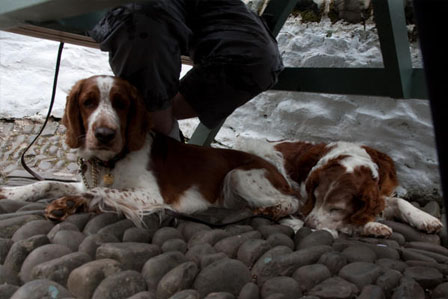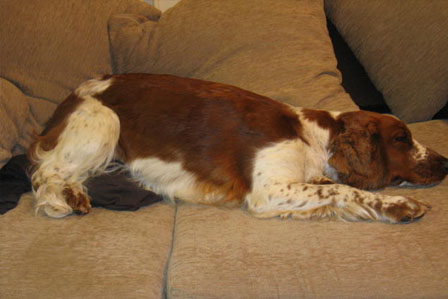
Description: A compact, medium sized dog with a silky dark red and white coat. The hair is straight or slightly wavy, flat and medium length with feathering on chest, underside, legs and tail. The head is slightly rounded and the muzzle is fairly square. The longish pendant ears are fringed with hair, somewhat like a setter's. The eyes are either hazel or dark coloured. The Welsh Springer is a bit smaller and lighter than the English Springer, and a bit taller and larger than the Cocker Spaniel.
Height: 45 - 48 cm (Male) (18 to 19 inches), 43 - 45 cm (female) (17 to 18 inches .
Weight: 17- 21 kg (38 to 48 pounds).
Availability: Difficult to find.
Personality:
- Happy, willing.
- Less outgoing than the English Springer.
- Somewhat independent, but also sensitive.
- The Welsh Springer needs to be included in family activities.
Behaviour:
- Children: Excellent with children.

- Friendliness: Reserved with strangers.
- Trainability: Easy to train.
- Independence: Not particularly dependent or independent.
- Dominance: Low.
- Other Pets: Generally good with other pets.
- Combativeness: Not generally dog-aggressive.
- Noise: Average barker.
Grooming and Physical Needs:
- Grooming: Regular grooming needed.
- Trimming & Stripping: Skilled trimming or stripping needed.
- Shedding: Average shedder.
- Docking: The tail now is customarily not docked.
- Exercise: Vigorous daily exercise needed.
- Jogging: An excellent jogging companion.
- Indoors: Fairly active indoors.

- Apartments: Will be OK in an apartment if sufficiently exercised.
- Outdoor Space: Best with at least an average-size yard.
- Climate: Does well in most climates.
- Owner: Good for novice owners.
- Longevity: Moderately long lived (12 to 15 years).
History: The Welsh Springer Spaniel is an outstanding hardy gun dog developed in Wales, probably before 1300 AD. The early history of the Welsh Springer is similar to that of the Cocker Spaniel, English Springer Spaniel and other spaniels of British origins. All the early spaniels were called Cockers, or Cocking Spaniels. There was no kennel club to regulate breeding, so the different types were often interbred. Later, spaniels were divided into Water Spaniels and Land Spaniels. Many early writings mention a "Welsh Cocker", which might have been the forerunner of today's Welsh Springer Spaniel. Through the years, more divisions were made. Springer's were separated from Cockers. The Welsh and English Springer's became separate breeds sometime before 1900. The Welsh Springer has great stamina and can work for hours on end without getting tired in all kinds of weather and on difficult terrain. The name comes from the fact that the breed is talented at finding and "springing" hidden game. His tail starts wagging faster when he discovers game. The jolly disposition of the Welsh Springer makes him a fine companion and family dog.
Health:
- The Kennel Club also provides information on the current health issues
- The Welsh Springer Joint Health Group website provides information on known health issues for this breed.
